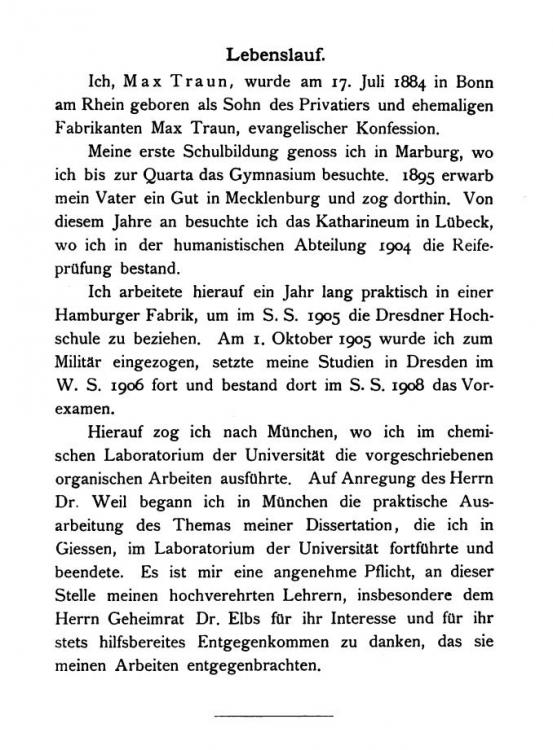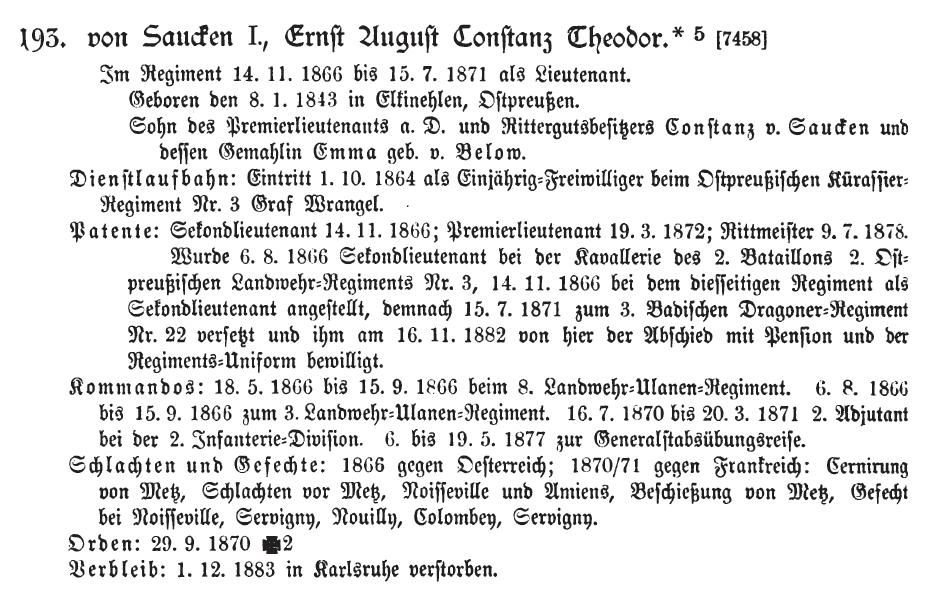-
Posts
4,908 -
Joined
-
Last visited
-
Days Won
97
Everything posted by Dave Danner
-
He received the SA3bX on 22.12.1914 as an Oberleutnant in Reserve-Infanterie-Regiment Nr. 102. He received the SA3aX on 17.1.1917 as a Hauptmann in Reserve-Jäger-Bataillon Nr. 12. He does not appear in any casualty lists, so no birthplace through that source. He was promoted to Fähnrich on 21.12.1906 in IR 178 and Leutnant on 19.8.1907 (Pat. 19.2.06), so he was probably born around 1888.
-
Under normal circumstances, I would agree. The KO3X is, as I noted, rather uncommon. And as I also noted, with a clip-on medal bar, medals can be easily removed. However, all four clips for the first four decorations are at the same height. If second place was for an HOH3X, the clip should be higher to account for the crown. It's not 100% either way, but the KO3X does fit. Also, the overwhelming majority of RAO4/HOH3X/DA recipients are known to have at least one Landesorden from another state besides Prussia. And that is even with all of the missing rolls, including those of several larger states such as Hamburg and Hessen. So, while the number of KO3X awards is small, so too is the number of known RAO4/HOH3X/DA combinations without a non-Prussian decoration.
-
Hi again, Yes that is reasonably likely scenario for the bar with the Bavarian order. However, there were plenty of awards of the Bavarian Military Merit Order with Swords to non-Bavarians and to Bavarians in the navy. So while it was most likely a Bavarian lieutenant, it could also have been a Prussian lieutenant in a unit like Infanterie-Regiment König Ludwig III. von Bayern (2. Niederschlesisches) Nr. 47. For the Wehrmacht Dienstauszeichung, the 4th Class here required at least four years' service. The next grade required at least 12 years' service. There was no double counting of wartime service, as with Prussian long service awards. The Wehrmacht Dienstauszeichung was first awarded on 2 October 1936 and awards were made until WW2 broke out in September 1939. So we know he was active between those dates, but cannot say for certain when he returned to active duty. The typical case was a wartime volunteer in 1914, commissioned as a Leutnant (der Reserve) during the war and released from service when the Imperial Army was drawn down between 1918 and 1920. As the Reichswehr/Wehrmacht was expanded beginning in 1934, many of these former officers were recalled, often as supplementary officers (Ergänzungsoffiziere). The typical former Leutnant was recalled as a Hauptmann (E). Since they usually only had 4-5 years of service in the Imperial Army, and less than 5 years' service in the Wehrmacht (1934/5-1939), they did not reach the 12-year threshold for the Wehrmacht Dienstauszeichung 3.Klasse. During the war, they might have advanced as far as Oberst. There were of course, exceptions, but this is a typical case. Many E-officers were only active in service on the homefront, so they may have only received a Kriegsverdienstkreuz 2.Klasse mit Schwertern during the war. They also may not have had an opportunity during the war to wear a full medal bar, so never bothered to upgrade the medal bar with any wartime awards.
-
Hi and welcome to the forum. Assuming the medal bar has not been tampered with, and the correct medals are there (with clips, obviously, medals can be switched out), the bar most likely fits field-grade officer (Major/Oberstleutnant/Oberst) who was retired during the war. The Crown Order 3rd Class with Swords (KO3X) was not a common award. Before World War I, it might have been awarded for China or colonial service to a senior field-grade officer, but in that case there would be a campaign medal (China, Southwest Africa or Colonial) on the bar. During World War I, the Order of the Red Eagle and the Crown Order were not commonly awarded in the lower grades, since the Iron Cross filled the role these orders did in the colonial wars. However, there were a number of awards, mostly to officers forced to retire or placed zur Disposition for various reasons. If these officers already had a Red Eagle 4th Class, the next decoration in the normal peacetime progression was the Crown Order 3rd Class. Since these officers had been at the front, in their case it was awarded with swords on the black-white ribbon. Other officers who retired during the war, but who had served in the Heimat, such as Wehrbezirk officers, might receive the order on the normal blue ribbon. As noted, there weren't many awards during the war. In the Militär-Wochenblatt, there were 51 KO3Xs gazetted (also 1 award of swords to a prewar KO3). The small number makes sense, since few officers retired during the war, since there was, of course, a war on. Those that did were usually forced to retire due to invalidity, in which case if they had enough service a decoration was appropriate, or due to incompetence, in which case no decoration was appropriate. Do you have a better picture of the medal bar? What is after the Ehrenlegion Medal?
-
Pfretzschner. Are you sure about the rank? In April 1873, Eduard Pfretzschner was a Rittmeister in the 4. Chevaulegers-Regiment. He was promoted to Major on 1 May 1873. He was retired sometime around 1875/76 and given the Charakter as Oberstlieutenant a.D. on 24 March 1885. He died on 7 March 1890 in München.
-
Thanks. That loop that looks like a tilde is apparently that mark in handwriting to distinguish a "u" from an "n". We're also lucky that the rank was Premierlieutenant, since that rank was Germanicized in 1899 or so to Oberleutnant. The DR 22 Stammliste came out in 1898, so he pretty much had to be in it. In a weird coincidence, given my typo above, I just came across a typo in the 1916 Saxon Militärverordnungsblatt where IR 178 was listed as IR 148. My typo makes sense, since 4 is next to 7 on the keypad on the side of my keyboard, but I would think the MVB was typeset.
-
Typo, should be 1843. That's pretty much all there is in the Stammliste. It does not even say which regiment he was in before DR 22. He was a Prussian, not a Badener, and did not start out with the regiment. However, after a little further digging, I found that he got his EK2 as a SekLt. in Ulanen-Regt. Nr. 8. The UR 8 Stammliste adds a bit more information:
-
August was promoted to Oberstleutnant on 1.3.15 and Oberst on 26.6.17. According to the 1916 k.u.k. Rangliste, Friedrich was promoted to Major on 1.8.14. He is not listed in the 1918 Rangliste. He may have been a casualty, but only about 10% of the k.u.k. Verlustlisten have been transcribed online. Josef (4.8.1875-10.4.1943) was promoted to Major on 1.1.18, so he seems to be the likely candidate. He was an Oberst (1.6.24) in the Bundesheer and retired as a Titular-Generalmajor on 23.4.28 (is "Tit." the Austrian equivalent to "Char."?).
-
Awards of the MMJO usually had three dates: an award date for the action, a bestowal date for when it was actually awarded, and an ennoblement date for when the officer, if a commoner, was ennobled as "Ritter von". The earliest Ritterkreuz actually awarded was the award to Generalmajor Karl Ritter v. Schoch, 4.bay.Inf.-Brig., with an award date of 26.8.14, a bestowal date of 18.9.14 and an ennoblement date of 1.2.15. Kapitänleutnant Otto Weddigen was the next recipient, on 11.10.14 (his award and bestowal dates were the same). As a Prussian, he was not ennobled. Generalmajor Maximilian v. Kirschbaum, 12.bay.Inf.-Brig., was next, on 31.10.14 with an award date of 25.9.14. Two more awards were made in November and three in December. Wilhelm II and Hindenburg also received their Grand Crosses in 1914. The earliest nominal award date, one day before Xylander, was the award to Adolf Denk of 2. bay. Schweres Reiter-Regiment. It was not bestowed until 26.2.16, but it was dated 9.8.14. He became "Ritter v. Denk" on 18.3.16. I don't have my MMJO reference books handy and I don't have a history of 2.SchwRR, so I can't say for certain what action the award was for. The Wikipedia article on the regiment says it was for the Gefecht bei Lagarde, but the article on that battle says it took place on 11 August. So maybe the dates correspond to the beginning of the operation and the citation makes it clearer that it covers the period from X to Y.
-
The name is Erasmus Wirsing. He was born in Bavaria but he lived in Homburg vor der Höhe west of Frankfurt am Main. His initial military service was in IR 88 and his wartime service was mostly in Hessisch/Nassauisch formations, until he ended up in the 121. Infanterie-Division (in RIR 56 and in the division trains) which was a mixed, mostly Rhineland, unit. According to his marriage certificate (on Ancestry), he was a baker in civilian life, so I imagine that's why he ended up in train formations.
-
Indeed. Being home to many of the major and minor North Sea and Baltic Sea ports, both the Grand Duchies of Oldenburg and Mecklenburg-Schwerin and the three Free and Hanseatic Cities made a lot of awards to naval personnel. III./IR 162 is merely the most direct connection between Lübeck and Oldenburg. Particular award combinations can sometimes strongly hint at certain units, but there are simply way too many variables. For every III./IR 162 recipient of the Lübeck and Oldenburg awards, there was probably some Lübeck native serving in IR 91, DR 19 or FAR 62 who also got both. And then the navy guys. And then the staff types. And then the guys who changed units. Or a Lübecker in 1.GDR, since the Grand Duke of Oldenburg was à la suite that regiment.
-
For the most part, the Grand Duchy was in a different Korpsbereich from the Hanseatic City of Lübeck. But as GreyC notes, Oldenburg had an exclave which bordered Lübeck. This exclave was named ... Fürstentum Lübeck. It had a population of about 41,000 in the 1910 census. The largest city was Eutin. Since Schloss Oldenburg is a state museum, Schloss Eutin is the current seat of the former ruling house of Oldenburg. As for a regimental connection, III.Bataillon of Infanterie-Regiment Lübeck (3. Hanseatisches) Nr. 162 was garrisoned in Eutin. That also would include any wartime Tochterformationen of IR 162, as well as a number of regiments which generally recruited from the Schleswig-Holstein area, such as RIR 84.






